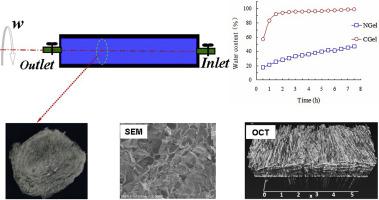当前位置:
X-MOL 学术
›
Mater. Chem. Phys.
›
论文详情
Our official English website, www.x-mol.net, welcomes your
feedback! (Note: you will need to create a separate account there.)
Relationship between tin environment of SnO2 nanoparticles and their electrochemical behaviour in a lithium ion battery
Materials Chemistry and Physics ( IF 4.3 ) Pub Date : 2021-01-01 , DOI: 10.1016/j.matchemphys.2020.123461 Charlotte Gervillié , Aurélie Boisard , Julien Labbé , Katia Guérin , Sandrine Berthon-Fabry
Materials Chemistry and Physics ( IF 4.3 ) Pub Date : 2021-01-01 , DOI: 10.1016/j.matchemphys.2020.123461 Charlotte Gervillié , Aurélie Boisard , Julien Labbé , Katia Guérin , Sandrine Berthon-Fabry

|
Abstract SnO2 nanoparticles were synthetized in three different ways (solvothermal, hydrothermal, sol-gel) and heat-treated under argon at 600 °C to obtain different physico-chemical characteristics (texture, structure and surface chemistry) determined by X-ray powder diffraction (XRD), infrared spectroscopy (FTIR), 119Sn solid state Nuclear Magnetic Resonance (NMR), Electron Spin Resonance (ESR), scanning electron microscopy (SEM) and 77 K nitrogen sorption. When used as electrode material in a lithium ion battery, their electrochemical properties were evaluated by galvanostatic measurements. Among crystallinity, particle size, specific surface area and associated porosity, hydroxyl groups and paramagnetic centers, only the last two parameters appear as determinants of electrochemical performance. Solvothermal and hydrothermal syntheses lead to the presence of certain hydroxyl groups in the oxide whereas sol-gel one prevents their formation but forms paramagnetic species. The hydroxyl groups favour a good coulombic efficiency and an interesting reversibility of the conversion process. Paramagnetic species limit the electrochemical process. Their elimination by a heat-treatment at 1000 °C under argon improves the electrochemical properties. Understanding the key factors to favour SnO2-based materials allows to obtain capacities of about 900 mAh.g−1 over 5 cycles.
中文翻译:

SnO2纳米颗粒锡环境与锂离子电池电化学行为的关系
摘要 SnO2 纳米粒子以三种不同的方式(溶剂热、水热、溶胶-凝胶)合成,并在 600 °C 的氩气下进行热处理,通过 X 射线粉末衍射测定获得不同的理化特性(质地、结构和表面化学)。 (XRD)、红外光谱 (FTIR)、119Sn 固态核磁共振 (NMR)、电子自旋共振 (ESR)、扫描电子显微镜 (SEM) 和 77 K 氮吸附。当用作锂离子电池中的电极材料时,它们的电化学性能通过恒电流测量进行评估。在结晶度、粒径、比表面积和相关孔隙率、羟基和顺磁中心中,只有最后两个参数作为电化学性能的决定因素出现。溶剂热和水热合成导致氧化物中存在某些羟基,而溶胶-凝胶可防止它们的形成但形成顺磁性物质。羟基有利于良好的库仑效率和有趣的转化过程可逆性。顺磁性物质限制了电化学过程。通过在氩气下在 1000 °C 下热处理将其消除,从而提高了电化学性能。了解有利于基于 SnO2 的材料的关键因素可以在 5 个循环中获得约 900 mAh.g-1 的容量。顺磁性物质限制了电化学过程。通过在氩气下在 1000 °C 下热处理将其消除,从而提高了电化学性能。了解有利于基于 SnO2 的材料的关键因素可以在 5 个循环中获得约 900 mAh.g-1 的容量。顺磁性物质限制了电化学过程。通过在氩气下在 1000 °C 下热处理将其消除,从而提高了电化学性能。了解有利于基于 SnO2 的材料的关键因素可以在 5 个循环中获得约 900 mAh.g-1 的容量。
更新日期:2021-01-01
中文翻译:

SnO2纳米颗粒锡环境与锂离子电池电化学行为的关系
摘要 SnO2 纳米粒子以三种不同的方式(溶剂热、水热、溶胶-凝胶)合成,并在 600 °C 的氩气下进行热处理,通过 X 射线粉末衍射测定获得不同的理化特性(质地、结构和表面化学)。 (XRD)、红外光谱 (FTIR)、119Sn 固态核磁共振 (NMR)、电子自旋共振 (ESR)、扫描电子显微镜 (SEM) 和 77 K 氮吸附。当用作锂离子电池中的电极材料时,它们的电化学性能通过恒电流测量进行评估。在结晶度、粒径、比表面积和相关孔隙率、羟基和顺磁中心中,只有最后两个参数作为电化学性能的决定因素出现。溶剂热和水热合成导致氧化物中存在某些羟基,而溶胶-凝胶可防止它们的形成但形成顺磁性物质。羟基有利于良好的库仑效率和有趣的转化过程可逆性。顺磁性物质限制了电化学过程。通过在氩气下在 1000 °C 下热处理将其消除,从而提高了电化学性能。了解有利于基于 SnO2 的材料的关键因素可以在 5 个循环中获得约 900 mAh.g-1 的容量。顺磁性物质限制了电化学过程。通过在氩气下在 1000 °C 下热处理将其消除,从而提高了电化学性能。了解有利于基于 SnO2 的材料的关键因素可以在 5 个循环中获得约 900 mAh.g-1 的容量。顺磁性物质限制了电化学过程。通过在氩气下在 1000 °C 下热处理将其消除,从而提高了电化学性能。了解有利于基于 SnO2 的材料的关键因素可以在 5 个循环中获得约 900 mAh.g-1 的容量。











































 京公网安备 11010802027423号
京公网安备 11010802027423号